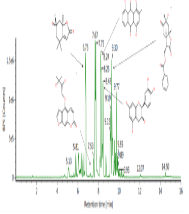In Vivo and In Silico Evaluation of Petroselinum crispum Leaf Fractions as Anti-Alopecia
Main Article Content
Abstract
Androgenetic alopecia (AGA), commonly known as baldness is marked by hair loss on the scalp or other body areas, ranging from small patches to complete hair loss, potentially leading to significant psychological stress. In AGA, the activation of androgen receptors shortens the anagen phase of the hair growth cycle, resulting in follicular miniaturization and production of thinner hair follicles that fail to penetrate the epidermis. This condition is characterized by a reduced anagen-to-telogen hair ratio and elevated levels of dihydrotestosterone (DHT). Empirical use of Petroselinum crispum leaves for treating alopecia has prompted scientific investigation. Previous in silico studies identified 24 compounds in Petroselinum crispum, with six of them showing potential binding to the androgen receptor and compete with DHT. This study aims to examine the anti-alopecia activity of Petroselinum crispum leaf ethyl acetate fractions in vivo and in silico. In vivo evaluation employed rabbit model of alopecia, while in silico evaluation employed molecular docking on the androgen receptor. Ethyl acetate fractions 2 and 4 demonstrated the highest hair growth promoting activity, with significant increases in hair length (1.11±0.02 cm and 1.23±0.01 cm, respectively) and hair weight (0.125±0.02 g and 0.10±0.02 g, respectively), comparable to minoxidil. LC-MS analysis of these fractions identified several compounds, with paeonilactone C1 exhibiting the highest binding energy (-6.6 Kcal/mol), surpassing that of minoxidil. Fractions 2 and 4 of Petroselinum crispum leaves showed the most promising hair growth promoting activity, and could be developed into a hair tonic for the treatment and prevention of alopecia.
Downloads
Article Details

This work is licensed under a Creative Commons Attribution-NonCommercial-NoDerivatives 4.0 International License.
References
Lolli F, Pallotti F, Rossi A, Fortuna MC, Caro G, Lenzi A, Sansone A, Lombardo F. Androgenetic alopecia: a review. Endocrine. 2017; 57(1):9–17.
Ho CH, Sood T, Zito PM. Androgenetic Alopecia. StatPearls Publishing, 2022.
Olsen EA, Bergfeld WF, Cotsarelis G, Price VH, Shapiro J, Sinclair R, Solomon A, Sperling L, Stenn K, Whiting DA, Bernardo O, Bettencourt M, Bolduc C, Callendar V, Elston D, Hickman J, Ioffreda M, King L, Linzon C, McMichael A, Miller J, Mulinari F, Trancik R; Workshop on Cicatricial Alopecia. Summary of North American Hair Research Society (NAHRS)-sponsored Workshop on Cicatricial Alopecia, Duke University Medical Center, February 10 and 11, 2001. J Am Acad Dermatol. 2003; 48(1):103-110.
Tanaka S, Saito M, Tabata M. Bioassay of crude drugs for hair growth promoting activity in mice by a new simple method. Planta Med. 1980; 40(Suppl.):84–90.
Hasanuddin S, Gozali D, Arba M, Ramadhan DSF, Mustarichie R. In Silico Prediction of Metabolite in Petroselinum crispum in Inhibiting Androgen Receptor as Treatment for Alopecia. Res J Pharm Technol. 2022; 15(3):1211–1218.
O’Boyle NM, Banck M, James CA, Morley C, Vandermeersch T, Hutchison GR. Open Babel: An Open Chemical Toolbox. J Cheminform. 2011; 3(33):1–14.
Ropp PJ, Spiegel JO, Walker JL, Green H, Morales GA, Milliken KA, Ringe JJ, Durrant JD. GypSUm-DL: An open-source program for preparing small-molecule libraries for structure-based virtual screening. J Cheminform. 2019; 11(1):1–13.
Jain AN and Nicholls A. Recommendations for evaluation of computational methods. J Comput Aided Mol Des. 2008; 22(3-4):133-139.
D’Arrigo G, Gianquinto E, Rossetti G, Cruciani G, Lorenzetti S, Spyrakis F. Binding of androgen-and estrogen-like flavonoids to their cognate (non) nuclear receptors: a comparison by computational prediction. Molecules. 2021; 26(6):1613.
Levita J, Rositama MR, Alias N, Khalida N, Saptarini NM, Megantara S. Discovering COX-2 inhibitors from flavonoids and diterpenoids. J Appl Pharm Sci. 2017; 7(7):103–110.
Farzaei MH, Abbasabadi Z, Ardekani MRS, Rahimi R, Farzaei F. Parsley: A review of ethnopharmacology, phytochemistry and biological activities. J Trad Chin Med. 2013; 33(6):815–826.
Zhao MB, Li J, Shi SP, Cai CQ, Tu PF, Tang L, Zeng KW, Jiang Y. Two new phenolic compounds from the heartwood of Caesalpinia sappan L. Molecules. 2013; 19(1):1-8.
Ahda M, Jaswir I, Khatib A, Ahmed QU, Syed Mohamad SNA. A review on Cosmos caudatus as A potential medicinal plant based on pharmacognosy, phytochemistry, and pharmacological activities. Int J Food Prop. 2023; 26(1):344–358.
Calonghi N, Farruggia G, Boga C, Micheletti G, Fini E, Romani L, Telese D, Faraci E, Bergamini C, Cerini S, Rizzardi N. Root Extracts of Two Cultivars of Paeonia Species: Lipid Composition and Biological Effects on Different Cell Lines: Preliminary Results. Molecules. 2021; 26(3):655.
Dhurat R, Sharma A, Rudnicka L, Kroumpouzos G, Kassir M, Galadari H, Wollina U, Lotti T, Golubovic M, Binic I, Grabbe S. 5‐Alpha reductase inhibitors in androgenetic alopecia: Shifting paradigms, current concepts, comparative efficacy, and safety. Dermatol Ther. 2020; 33(3):e13379.
Lee DK and Chang C. Endocrine mechanisms of disease: Expression and degradation of androgen receptor: Mechanism and clinical implication. J Clin Endocrinol Metab. 2003; 88(9):4043–4054.
Hsu CL, Liu JS, Wu PL, Guan HH, Chen YL, Lin AC, Ting HJ, Pang ST, Yeh SD, Ma WL, Chen CJ. Identification of a new androgen receptor (AR) co-regulator BUD31 and related peptides to suppress wild-type and mutated AR-mediated prostate cancer growth via peptide screening and X-ray structure analysis. Mol Oncol. 2014; 8(8):1575–1587.
Suzuki T, Kitamura S, Khota R, Sugihara K, Fujimoto N, Ohta S. Estrogenic and antiandrogenic activities of 17 benzophenone derivatives used as UV stabilizers and sunscreens. Toxicol Appl Pharmacol. 2005; 203(1):9–17.
Pan TL, Wang PW, Aljuffali IA, Leu YL, Hung YY, Fang JY. Coumarin derivatives, but not coumarin itself, cause skin irritation via topical delivery. Toxicol Lett. 2014; 226(2):173–181.
Rushton DH. Nutritional factors and hair loss. Clin Exp Dermatol. 2002; 27(5):396–404.
Jara CP, de Andrade Berti B, Mendes NF, Engel DF, Zanesco AM, Pereira de Souza GF, de Medeiros Bezerra R, de Toledo Bagatin J, Maria-Engler SS, Morari J, Velander WH. Glutamic acid promotes hair growth in mice. Sci Rep. 2021; 11(1):1–13.
Kasmawati H, Mustarichie R, Halimah E, Ruslin R, Arfan A, Sida NA. Unrevealing the potential of Sansevieria trifasciata prain fraction for the treatment of androgenetic alopecia by inhibiting androgen receptors based on LC-MS/MS analysis, and in-silico studies. Molecules. 2022; 27(14):4358.


